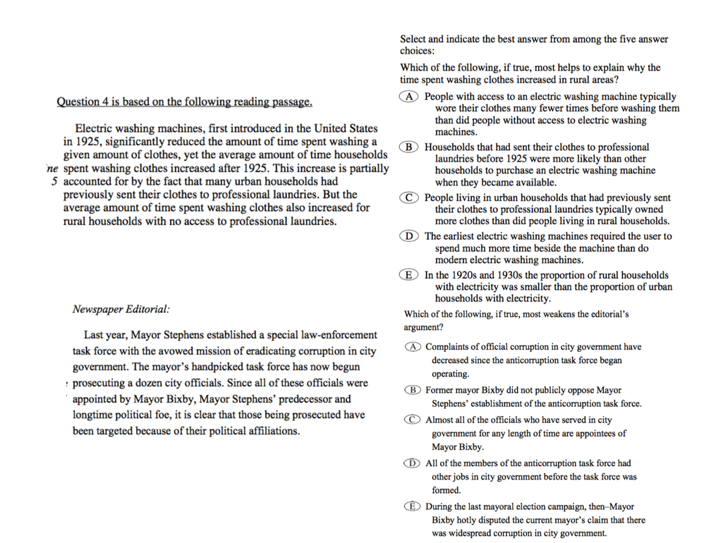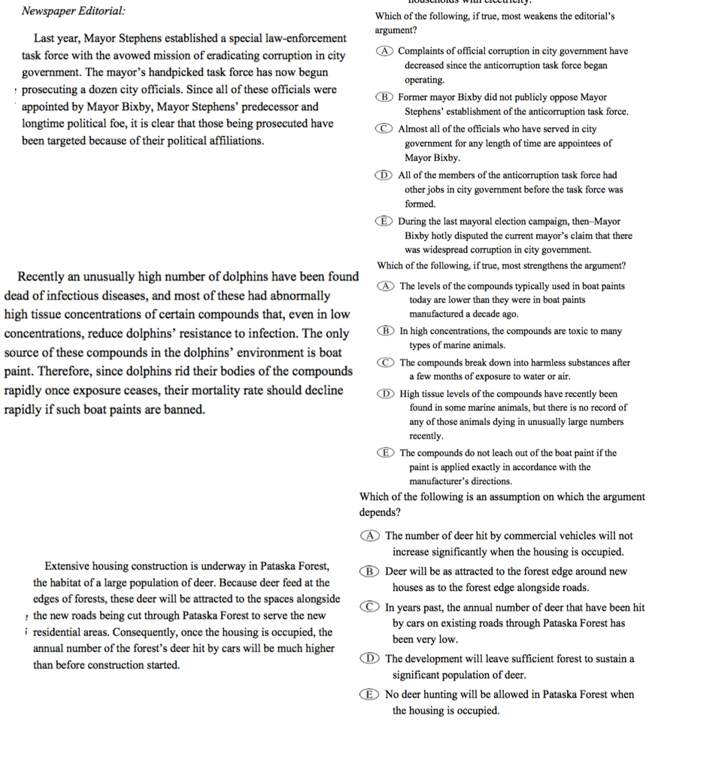One of the main challenges of the GRE’s Reading Comprehension questions is that, unlike math, there are no set formulas to learn. This can make Reading Comprehension...
GRE Guide: Single Question Passages
 Perhaps the most overwhelming thing about the GRE is the test itself, as a whole. This article from HappySchools outlines the content and general format of the exam. The terrain covered by even the most conservative subsections can feel constantly in flux – and when most questions are asked only a single time on the test, prepping on a smaller scale often feels futile. But further compartmentalization actually breaks the test into fully digestible pieces, and when we look at the species of questions that exist in a micro-sense, we can see better when certain skills are being evaluated more than others. Noticing these differences is key to succeeding on the test, as going without often leads us to throw all of our skills at each question, a process that is draining and overwhelming. By noting the differences and curating our approach in a more fine-tuned way, we can save energy for later in the test, and have a better sense of question-consciousness, where we as test takers are responding to the questions as they are being asked, and not as we fear them to be.
Perhaps the most overwhelming thing about the GRE is the test itself, as a whole. This article from HappySchools outlines the content and general format of the exam. The terrain covered by even the most conservative subsections can feel constantly in flux – and when most questions are asked only a single time on the test, prepping on a smaller scale often feels futile. But further compartmentalization actually breaks the test into fully digestible pieces, and when we look at the species of questions that exist in a micro-sense, we can see better when certain skills are being evaluated more than others. Noticing these differences is key to succeeding on the test, as going without often leads us to throw all of our skills at each question, a process that is draining and overwhelming. By noting the differences and curating our approach in a more fine-tuned way, we can save energy for later in the test, and have a better sense of question-consciousness, where we as test takers are responding to the questions as they are being asked, and not as we fear them to be.
A couple years ago, I took this approach with a client to study the differences that crop up when we cut up and separate multiple official practice exams (and official here is key, as most test prep companies write their own material based on content areas and not question style). We focused on the Reading Comprehension questions in the Verbal section, and I intend to write 3 following blog posts laying out the differences we discovered through this process, beginning with single-question passages. By “single-question,” I’m referring to all of the questions that only require you to respond to an individual question; the other three varieties, naturally, are 2-question, 3-question, and 4-question passages, the last of which can be particularly nasty. But points are equivalent across the board, and you will see more single-question passages than 4-question ones, so we’re starting at the beginning.
Take the following problem:
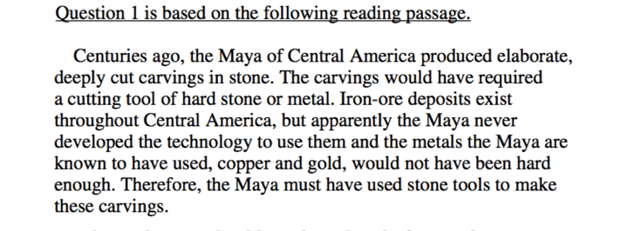
This question is about the standard length and style for single-question passages, which are, the vast majority of the time, concerned with the logic of the passage. The question asked will also almost always be similar to “Which of the following, if true, most strengthens or weakens the argument?” In this case, the question will ask us about weakening the argument, but we need first to understand what that even means. For more information about the style of GRE Reading Comprehension questions, see this article from GREEdge.
On the GRE, the term argument always refers to the logic as it produces the conclusion. So for our purposes, we can focus on the part of the passage that says “therefore” or some variation. Here, that part is that “the Maya must have used stone tools.” This conclusion is fundamentally the thing we are trying to weaken as we analyze the argument, but lets look closer at the pathway there.
The Maya made carvings. The carvings would need hard stone or metal tools. Alright, let’s stop here for a sec. Neither of those things is untrue – in fact, we can’t take anything they say as untrue. A common mistake in students is that they assume what would weaken the argument is an alternative fact (like what if they had lasers?!?). But it’s clear here that if we start at two options (stone or metal) and conclude that stone is the answer, what we need most to weaken the argument is an alternate source of metal.
Iron-ore deposits existed, but the Maya never figured out how to use them. We know they used copper and gold, but these aren’t hard enough. THEREFORE, they must have used stone. This could be a totally correct argument; I mean if there really was no other source of metal, we’d have to agree. But since our project is to weaken the argument, that’s the thing we need to produce.
We’re going to look at the answers in a second, but before we do, I want to offer some cautionary advice – the test writes questions in ways to slow you down. It is not your friend, and it wants you to spend more than a handful of minutes on each question – this ensures you’ll take the test again in a few months. They aren’t incentivized to make it easy for you, and one of their best tricks is providing you with answers that are convoluted and messy so that you have to read them several times. So when I show you the answers, glide on past them to my analysis of them, and use that as a frame for breaking it down.
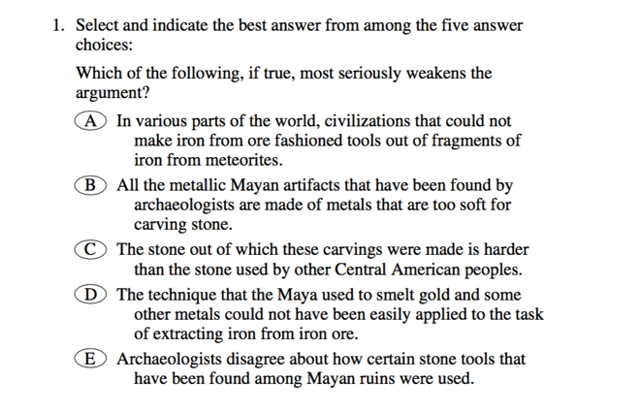
Remember, our goal is to weaken the argument that concludes that stone must have been used, and that a framework for thinking about that is that we want an extra source of metal. As we read from the bottom up, lets look at these answers. The final answer primarily discusses how archaeologists disagree about stone tools. This is of no concern to us, as our primary concern revolves around finding additional sources of metal. This answer can be marked irrelevant. The penultimate answer choice discusses the smelting technique – which, if it could be applied to Iron, would provide us with a new source of metal. However, they say it could NOT be so used, and thus this answer strengthens the argument. This is a difficult choice primarily because it’s an example of the test masking a wrong answer with right clothing, and these are especially tricky to watch out for.
Answer C discusses the hardness of the stone, and once we recognize that fact we know immediately that whatever effect it might have on the argument, it is not for us. We care about metal, single-mindedly. Answer B provides an example of artifacts that have been found, but reiterates that these would have been too soft. No luck, once more. But Answer A refers to a meteorite that, even in the hypothetical, would provide a source of metal that the passage failed to address, and so produces the possibility of weakening the argument.
The struggles that I see most students facing in problems like this is first, substituting facts they imagine about the passage for the logic the passage presents to us; second, forgetting the hole in logic they are looking to exploit as a result of the length and difficulty of the answer choices; and third, misreading the answer choices (as Answer D tries to provoke). To fight these, remember that the passage only speaks in facts until its conclusion, which is simply poorly drawn, not wrong as such. Also, maintain your focus on this hole – if you can say “new source of metal” don’t substitute it for something you read that’s different without double and triple checking. Third, read carefully, and always keep at the forefront of your mind that the test is messing with your attention span and actively, constantly trying to throw you off your game.
To look at another question like this, check out the one below:
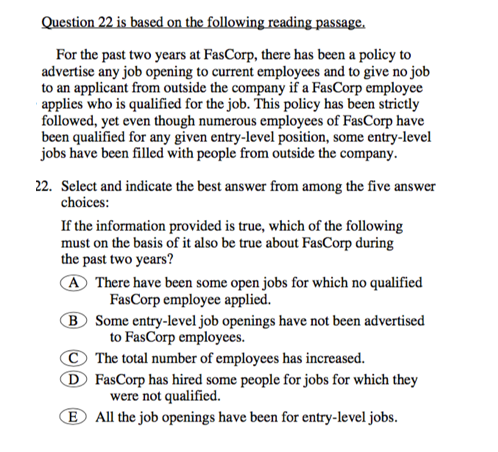
This technically doesn’t ask to strengthen or weaken, but notice how attentive the question is to the passage’s logic. “Which of the following, if true” remains our hallmark, but the thing we’re looking to do is draw a conclusion about the facts presented to us, so we are in a slightly different capacity. But if we break down the passage into its basic sequence of facts, it looks a lot easier to think through.
No job goes to an outside applicant if an internal applicant who is qualified applies. [In pure logic terms this means – If internal applicant applies and is qualified, they get the job.] Numerous employees have been qualified for any given positions. Some of those positions go to outside hires. At this point we almost have the answer in front of us, and we haven’t even looked at the answers, because the passage lays out its own logic for us. Many are qualified, but some jobs go to outsiders could only suggest that some who are qualified have not applied (which would be easy to imagine for entry-level positions).
Answer A most exactly looks like this variation, as it discusses the lack of applications from current employees. But let’s check out the other answers. Answer B suggests a lack of notification to current employees. This is wrong in the first place because the opening sentence refers to advertisement and this answer would depend on the statement in the passage being false. But it fails, also, to address the problem of “application” and so can be discarded before even realizing all that. Answer C is little more than a possible fact, which might be true (given that employees + outside hires = more employees), and its truth can easily distract us from the focus on the passage’s logic. But it might also not be true; if the turnover is consistent the employee count might stay pretty low.
Answer D references the non-qualification of certain hires – this is a great example of the kind of alternative-fact that students often fall for. These kinds of answers distract us by their power to transform the conclusion without being within the logical realm of the question. The problem, remember, is the non-application of certain current employees, not the qualifications of those who are hired, which the passage implies strongly actually possess those qualifications. Answer E might also be true, but bears no relevance to our logical conundrum and should similarly be discarded.
These single-question passages will appear 3-4 times on your Verbal section, and as a result will come in a variety of logical flavors, even though they hew closely to the same format. It’s worth familiarizing yourself with them and their question styles and answer choices the same way you would prep your knowledge of triangles for the math section. Your job in reading comprehension is not just the flimsy concept of “comprehension” – it can be compartmentalized in similar ways to the math section and gradually, studiously conquered.
Stay tuned for future installments! And enjoy these similar questions below.
About the Author
Ben is one of MyGuru's most experienced and qualified GRE/test prep tutors. For more information on him and others like him, click here.
